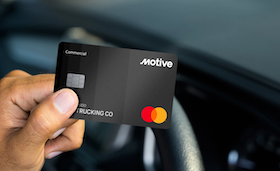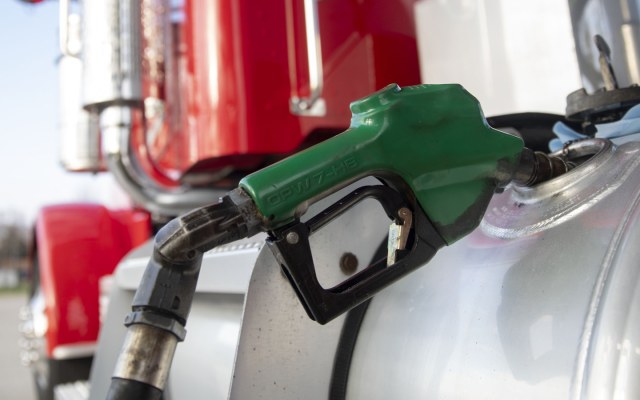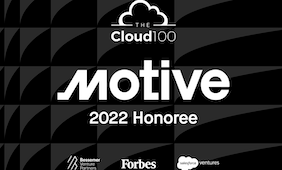On-demand webinar
Fall Motive product showcase.
Discover what’s new in Motive’s all-in-one solution
Duration:1 hr
Webinar Details
To continuously support our customers, no matter the economic state, we are always innovating and launching new features. It can be hard to keep up with what’s new and remember how to take advantage of Motive’s all-in-one solution.
Join us for a quick run down of the latest Motive releases, including a new cold chain monitoring solution, safety AI models, and improved inspections workflow.
You’ll learn more about:
- Get caught up on new Motive releases
- Learn how to maximize ROI using available solutions
- See additional Motive resources you might’ve missed
Speakers
Transcript
Hi, everyone. Thank you for joining us today. I’m Joanna Vargas from Motive’s product marketing team and we’re excited to share with you some of Motive’s latest product releases. You’ll have the opportunity to input any questions you may have throughout the presentation and we’ll answer them at the end. So over the next hour, we’ll be going into detail on safety AI models and improved inspections workflow, and a new cold chain monitoring solution.
View More
0:00 | Joanna Vargas
Hi, everyone. Thank you for joining us today. I’m Joanna Vargas from Motive’s product marketing team and we’re excited to share with you some of Motive’s latest product releases. You’ll have the opportunity to input any questions you may have throughout the presentation and we’ll answer them at the end. So over the next hour, we’ll be going into detail on safety AI models and improved inspections workflow, and a new cold chain monitoring solution.
All right, before we dive into any new product features, I wanted to give a brief rundown of Motive’s vision and how we’re constantly innovating to support you. So Motive’s automated operations platform is a fully integrated suite of products that connect and automate physical operations. Sitting atop our IoT platform are a range of applications that automate major workflows that are critical to running a safe, productive, and profitable business, including driver safety, compliance, spend management, and more.
So today I’m joined by a few of our product experts who have been deeply involved in developing and rolling out these new features to our customers. David Chow, Senior Product Manager, Devin Smith, Senior Product Manager, and Todd Burch, Senior Product Marketing Manager. And to kick us off, I’m going to turn it over to Devin now to share some exciting new developments in Motive’s AI models.
1:34 | Devin Smith
Awesome. Thank you, Joanna. Hi, everyone. My name is Devin Smith, and I am a product manager at Motive, here to speak with you about some of our latest AI model updates that are now available on the AI Dashcam.
Before I get into that, I did want to take a moment and lean into a shameless plug that myself and everyone here at Motive are particularly proud of, and that’s to highlight the fact that in a recent independent study conducted by Strategy Analytics, Motive has proven to be the most accurate and fastest AI Dashcam when compared to other leading providers.
Now, each vendor was simultaneously tested across 342 test cases that span five different unsafe driving categories. Those are phone calls, phone and lap, close following, seatbelt use, and texting. The results showed that our dashcam was able to detect these unsafe driving behaviors 89% of the time.
We were also additionally acknowledged to have the fastest in-cab alerts, the best image and video quality content, as well as the preferred hardware design when compared to our counterparts. Now, I say all of this not in an effort to disparage our competitors, but more specifically to emphasize to you, our customers, how much we invest in this product, how important driver safety is to us, and how much we appreciate your continued investment in Motive, both financially and through our product feedback cycles.
We really want to thank you for your continued support and for joining us today to learn more about what’s new with our AI Dashcam. Before I head to the next slide, if you had not had a chance to review this report and are interested in learning more, please visit our website at go-motiv.com or speak with one of our account executives who can give you more information.
So what does all this mean for our customers? Well, at the end of the day, it ultimately means safer drivers on the road. Our technological approach has been so far to utilize AI vision coupled with in-cab alerting that help create those safer drivers.
But the core philosophy behind the technology is effectively building long-lasting, safer driving habits that stick with the driver and that’s hopefully applied to both their professional as well as their personal time on the road. Fortunately, across our customer base who utilize the AI Dashcam, we’ve been able to see a reduction in accidents by 22% as well as a 56% reduction in safety-related incidents.
We believe we have a lot more opportunity to continue to improve these metrics as we continue to work closely with you, our drivers, our safety managers and partners across the platform as we continue to evolve the safety product here at Motive. In terms of what’s the latest and greatest from our AI Dashcam, let’s talk about our latest AI detection model, rolling stops.
Now, I assume everyone here has a very vague definition of what rolling stops is, but before we get into specifics, I did want to spend a minute and show a quick example of the type of rolling stop that we’re looking to detect in this new model. As you can see, this driver is on an off-ramp approaching an intersection on a local road with no intention of actually stopping at this stop sign.
The driver continues forward and in this case, thankfully, no one is on the road at this time, but this is the type of scenario that we’re looking to track and to educate drivers to create safer driving habits. In this case, we’re able to generate an in-cab audio alert, if you could play that sign. Remember to make a complete stop at stop signs.
So here we want to remind the driver, please, at least on your next event when you’re approaching a stop sign, to please stop, but we’ve also created an event. So the event will be also available to a safety manager to review in our mode of dashboard, as well as for the driver in the mode of driver app. This allows the opportunity for both the safety manager and the driver to have a cohesive conversation about what exactly happened when this event was generated and it equalizes the discussion of both parties having the same information at hand.
As with all of our AI models over this time, this data can be used to improve driving behaviors and create safer driving habits or become a key decision point as to whether or not you continue to employ that driver at the company. At the moment, this model has an accuracy precision rate of about 83%, which will continue to improve over time in the next few iteration cycles as we train the model with more data.
Next up is our distracted driving AI model. This model specifically tracks behavior across three different categories related to drowsiness, distraction, or if a driver is using their cell phone. Our key trigger point here is determining whether or not the driver is looking down for three or more seconds.
Let’s take a quick look at this video and see exactly what we’re talking about. In this case, we have two individuals in the vehicle on a local road going above 10 miles per hour. And you can see that this driver is checking his phone multiple times. And at the tail end of this event, it’s for a duration longer than three seconds.
So again, in this case, we’re able to generate an in-cab alert to advise the driver to please keep their focus on the road. And again, we will create an event that is available for both the back office and the driver to allow for that opportunity to train and coach that driver to improve this behavior and ultimately creating safer habits for this driver over time.
At the moment, our model precision is around about 90%. And as mentioned with rolling stops, we’re going to continue to improve this metric over time. We believe this model specifically is going to have a very high impact as it relates to safety-related collisions.
Distracted driving accounts for about 25 to 30% of all vehicle-related collisions on the road. And as we’re able to enforce and update drivers on their behaviors while they’re driving, we believe that this model specifically will help reduce accidents in the field. As far as our updates, that’s it in terms of new AI models that are now available on the AI Dashcam.
I want to thank everybody for your time, and I’m going to pass the mic over to our wonderful host, Joanna, who will introduce the next topic. Thank you.
7:38 | Joanna Vargas
Thanks, Devin. We’re currently rolling out an update of our inspections workflow to improve the process. I’ll be going over what’s new and also share some initial feedback that we’ve received from our customers.
Before I get started, I wanted to thank you guys, our customers, for providing us feedback so we can continue to iterate and improve our products. With that, the first update for inspections is separating vehicle and trailer or asset inspections.
Users are now able to create asset inspections separately from vehicle inspections, which allows for separate settings, alert configurations, and record keeping. This will give fleets additional flexibility to customize their inspections workflow. Secondly, we’ve introduced a new inspection form setting for fleet managers to set additional driver requirements for inspections, which will help increase driver accountability by providing a template for accurate and thorough inspections during walkthroughs.
New settings include allowing the fleet manager to specify detailed driver requirements to inspect specific parts or all parts, add images of defects, add notes, and more. Vehicle maintenance violations are a huge threat to a carrier’s safety record. There are over 200 separate violations on FMCSA’s list of point-carrying infractions. Infractions such as issues with vehicle lighting, brakes, and tires are common violations that can easily be mitigated with thorough inspections to keep your CSA score low and your fleet safe.
Last new update on the inspections front is a new auto-fill license plate feature for Canadian inspections. This will help increase compliance and eliminate manual license plate input for our Canadian customers and those who have cross-border fleets.
As I mentioned earlier, these new inspection features are rolling out in phases over the next month or so. We’re happy to have heard some early feedback that things like separating the vehicle and asset inspections and mandating additional requirements in the inspection forms are helpful improvements to our customers’ inspection process. That concludes the inspections update.
The next new feature we’ll be sharing is Motive’s Thermo King integration and Reefer Monitoring solution. Companies transporting temperature-sensitive goods need real-time visibility into the status of transport refrigeration units to ensure that their cargo remains high quality upon delivery.
Motive’s Thermo King integration is an exciting new partnership that connects Thermo King reefer units to the Motive automated operations platform, which allows customers to stay compliant while eliminating errors and reducing operating costs.
So now I’m going to hand it over to Todd to go into more detail on the integration and how it automates reefer management.
10:52 | Todd Burch
Thank you, Joanna. We are in the digital era of cold chain logistics now, yet it’s still estimated that 20 percent of cold chain goods spoiled during transportation.
Next slide. With this, even in the digital era of logistics, our customers still face manual cumbersome processes to access their temperature logs.The FDA has increased rules and regulations through the Food Safety Modernization Act, requiring cold chain transporters to have more control over their temperature logs in case they need to trace the record of it.
Our customers also face rising costs and complexities with operating their refrigerated fleets, and there continues to be a lot of manual processes with programming and inspecting trailers. At Motive, our mission is to unlock the potential of the physical economy.
By working with OEMs and like Thermo King, we’re open to mitigate food spoilage, increase customer satisfaction, and lowering the operating maintenance costs of the reefer trailer units by proactively detecting problems. Our solution also enables customers to remotely program and control the units, which eliminates the need for drivers to manually pre-cool them hours before a trip and reduces the potential for human error.
How this works, by attaching a mode of Asset Gateway to the nose of a trailer and cable connecting it to the Thermo King unit, a customer can access reefer telematics and environmental conditions of their Thermo King trailer.
So, we know that cold chain is big business and stakes are high. The implications of a poorly maintained and monitored reefer unit can go far beyond just monetary losses. There’s certain types of cargo, like food or drugs, that if they fall outside of a temperature tolerance can have hidden complications and risks for people that consume it.
So, we thought the best way to start is to give easy access to temperature logs. And this is where the mode of solution starts. Through the Thermo King integration, customers can have access to their temperature logs anytime they want, full access from the moment they install the Asset Gateway, and cable connect it, and start their subscription to the end.
Also with access, you can export your logs to any sort of analytic tool, local storage, anywhere that you want for the historical temperature logs. In addition to access and the ability to put them and export them anywhere you want, the temperature logs through this integration are real-time and continuous. That means if you have a driver sitting at the dock to unload, they can access the temperature logs, the current temperature logs at that moment to share with any sort of receiver or warehouse.
In addition, this is what this will look like, these temperature logs, is what we call the reefer activity report. In the reports tab of the Motive Fleet Dashboard, you can come in, you can select the asset, you can select a period of time.
If you have multiple zones in your trailers, you can decide which zones you want to include in the report, and you can pick between intervals of 15 minutes and 30 minutes and one hour to pull those environmental conditions in the report. This gives you the ability to look and analyze your historical reports, see the performance of individual trailers, and better equip yourself with data.
So at a minimum, we think a reefer monitoring solution should help you monitor the environmental conditions of your trailer, but there’s times when that trailer is on the road and it’s too late. Let’s say it falls out of a certain temperature range. We believe through our Thermo King integration that we can help you proactively address some of these cold chain issues.
Sorry. Yeah, we believe that our Thermo King integration will help you proactively solve these solutions. In order for this to happen, the bread and butter of our solution is that we integrate your reefer telematics into our larger automated operations platform. This gives you the context of your reefer environmental data inside of your larger fleet operational data.
For example, here is a view of our fleet view. We have simple tools like a snowflake icon for your reefer trailers. You have the ability to hover over this icon and kind of get a snapshot of the data happening, but you’re also able to kind of see your fleet at the same time. Also through the Motive Fleet Dashboard, you have the ability to view alarms.
We’ve heard kind of through beta testing … we’ve heard of examples like this that sometimes fleet managers aren’t even aware of certain alarms that pop up during an inspection period. Drivers sometimes will clear those alarms just to get to the pre-cooling stage. Here through the Thermo King integration, you’ll have the ability to see those alarms before you start your pre-cooling.
So, kind of the third part of our solution is reducing programming errors. At this point, we know that a lot of drivers, it’s dependent on one person, the driver, to make sure that a reefer unit is programmed properly with the right set temperature and the right mode.
With our solution, we give you a fail-safe. We give you more eyes on that program, those modes, and on those temperatures. So, through this, not only do you have visibility into how your reefer trailers are performing, but you also gain centralized control of how those trailers are set. You can queue up a bunch of commands for your trailers in the Motive Fleet Dashboard and set those temperatures and modes for your trailers.
So, we also know that you can set a trailer to a certain temperature, and the goal is to have it operate a certain way, but sometimes trailers fall out of a certain temperature range. For that, we have a solution, so you don’t have to always actively monitor those trailers. You can set up alerts, and you can determine when those alerts should trigger, at what temperature.
You could decide who should receive this message, and you could prioritize how big of a deal is this alert at the same time. And this gives you peace of mind, knowing that you don’t always have to watch your screen and make sure that your trailers are within a certain temperature, that if you did stuff that way, that you would be notified of those changes.
And so, for the next step, we talked about the benefits of the Motive Thermo King integration. We have a pre-recorded demo to walk you through the features in the Motive Fleet Dashboard.
18:29 | Recorded Demo
Through the Motive Thermo King integration, there’s now an easy way for us to find a reefer on the Motive Dashboard.
Look for the snowflake icon on Fleet View to identify the reefer, and by hovering over it, you can see a snapshot of the current telematics. If you move to the one just below it, you can see that this reefer is actually turned off. Now, let’s say that we’re interested in getting more details about this active reefer. We can click on the asset, and it will take us to the asset page, where we can see even more live data flowing in.
When you hover over the info bubble, you can see that this is from our Motive Thermo King cable integration. If there are any issues with the reefer unit, they’ll show up in the alarm section directly below the telematics section, and this reefer seems to be working just fine.
If you want to operate the reefer unit remotely from the dashboard, click on configure, and a side panel will open up. Let’s say that we wanted to remotely turn on a reefer. For demonstration purposes, we have a different reefer turned off, waiting for us to turn it back on.
From that same side configuration panel, we can remotely turn on our reefer by toggling this button. This turn-on command will travel from our Motive Dashboard to our Asset Gateway to communicate with the Thermo King reefer. As you can see, after just a couple minutes, the reefer was successfully turned on remotely from our desk, and the dashboard was updated with the newest status.
We can also change the mode, setpoint, and run a pre-trip cycle using the same method. Next, let’s hop over to take a look at our temperature reports. This will show an expanded historical view of the specific reefer that we were just looking at.
We can change the time frame, the cadence, and data being shown to fit our needs. We can also export this view by just clicking on export for the worst-case scenario where we may need to dispute a load claim.
Finally, to wrap up, the last feature for passive monitoring is the temperature alerts. When we head over to the admin panel to our existing alert system, the user can set up an alert to notify them if a specific reefer or reefers has strayed from a temperature range for a certain period of time.
If these conditions have been met, then a notification and or email will be sent to the selected people to notify them of a potential issue. A great tool for increasing visibility along with providing peace of mind. All right, that’s it for Motive’s Thermo King integration. Thanks for tuning in.
21:27 | Todd Burch
Yes, the Motive Thermo King integration is available now, so talk to your Motive representative to learn more. And back to you, Johanna.
21: 43 | Joanna Vargas
All right, awesome. Thanks, Todd, for the details on reefer monitoring. So we are really excited about providing our customers another tool for managing their operations and maximizing refrigeration uptime. So this wraps up the product portion of the webinar.
Before we move on to Q&A, I wanted to briefly share on the screen a few resources that you might have missed from Motive. This includes our new fuel ROI study, a dashcam head-to-head comparison, our safety ROI study, and our Motive Card.
So we’ll be sending an email with links to resources like our new studies that you might find useful. Okay, so now we’ll open up the floor for some Q&A before we wrap things up. So let me pull up some of the questions.
All right, so one of the questions is on safety. So the question is for close following, how can we adjust the close following parameters?
22:56 | Devin Smith
Great question. Yeah, sure. So at the moment, we don’t offer the ability to modify these thresholds yourself in the dashboard. The good news is we’re actually developing features now to extend those capabilities. And you should see more of that coming in early 2023.
But to answer the direct question, to be able to modify these thresholds, you can simply contact your customer service representative, and we’ll be able to modify those thresholds on our side. And then if you want to adjust any other AI behaviors as well, same thing.
23:30 | Joanna Vargas
Awesome. Thank you. That sounds good. There is another question around dash cams. So the second question is also for you, Devin. Does Motive offer side cams, and will side cams be integrated into turn signal operation?
23:47 | Devin Smith
So we do not offer side cams just yet. However, I will say that we are getting into the beta testing phase of it. So we should be able to see a launch of this product in early 2023. As it relates to integrating with signal lane detection, we are exploring that type of integration as well.
The primary release candidate for this product will mostly be around just raw video related to exoneration of existing AI detection events that we are able to capture now, but we will further integrate that product into more intelligent scenarios that will allow for this type of tracking.
24: 29 | Joanna Vargas
Awesome. Thank you. So there is a question around fuel. So the question is, this wasn’t really covered today, but is there a way to fine-tune driver scores? So for example, this person has numerous trucks that require PTO operation and the accumulated idle time takes away from overall driver scores.
So the answer to that is yes, we’re currently building the ability to create custom scores at this time, and we’ll have more information about these features in the first half of next year. So that’s something that’s upcoming.
All right. Let’s see, there is a question on the asset … sorry … yeah, the asset tracker. So the question is for David or for Todd. So does the cable that is used to attach refer to asset tracker also keep the asset tracker charged? Does it plug into the same ports on the asset tracker?
35:43 | David Chao
Yeah. Is my webcam working? Okay. Yeah, I’ll take that one. So the … I guess a little bit show and tell … Yeah, the Asset Gateway, the cable will go, it looks just like this. It’ll go, the DB 15 and will go into the DB 15 port and this will go into the reefer.
And like most of our trailers, it’s not all of our trailers’ cables are, it will keep your Asset Gateway power when the refer is turned on or whatever power source is turned off. And then when it’s connected or run off the internal battery and pull only when needed, that would keep your reefer battery from draining.
26:20 | Joanna Vargas
Awesome. Thanks, David. Love the show and tell. All right. There’s a question about integration. So are there plans for carrier reefer integration? I think the answer is yes to that. So I’ll go ahead and .…
26:38 | David Chao
Yeah.
26:41 | Joanna Vargas
All right. So there’s another question on DVIR. So with the new update, will we be able to continue to do tractor or trailer asset inspections combined with the vehicle inspections or are we required to do separate inspections? So the answer is because we’re changing the configuration of inspections, new inspections moving forward will be required to be separate. So there’ll be no more option to do the old method of combined inspections.
Okay. I’m going to jump on to a safety question. So this will be for Devin. The question is, is there a place to see the AI model settings for events? Lots of drivers ask to understand the rules.
27:34 | Devin Smith
That’s a great question. Actually, it’s a lot of feedback that we’ve received from a lot of the other customers as well. At the moment, no, we don’t really expose the kind of the juice behind how these AI models are generated to either our drivers or fleet managers are having said that we’re actively updating our products to educate drivers on the mobile app, as well as on the Motive Dashboard on how exactly these events are created.
When we couple that with configuration management as well, both the driver and the back office will have a lot better understanding of how these events are created and tweak them to their needs.
28:16 | Joanna Vargas
Awesome.
Sounds good.
There’s a few more questions around safety, so maybe we’ll just get through those. Lots of interest. The next question is, will rearview cameras have a live view when the truck is thrown into reverse?
28:33 | Devin Smith
Along similar lines to the side camera question, our first pass at bringing this live to customers will effectively be around post-event exoneration video capture. As we get this product out and start to improve it and learn more about some of our customer use cases, this is absolutely one that we would be exploring as well as integrating a live view by adding that rearview camera to your vehicle.
28:59 | Joanna Vargas
Great. Sounds good. There’s another question about rolling stops. So the question is for rolling stops, is that considered a stop sign violation under the alerts or is that something different?
29:14 | Devin Smith
That’s correct. It is in the company settings when you enable this feature, it’s currently labeled as stop sign violation.
29:21 | Joanna Vargas
Okay. Awesome. Thank you. Let’s see. There is a question on, a lot of questions. Okay. There’s a question on maintenance, so I can probably take this line, but it says under the maintenance tab, are you guys planning on creating a tab where we can get messages back to the drivers if we are waiting on vehicle parts where we will not be able to fix our truck that day?
So the answer is yes, this is in the roadmap. We’re working on something where fleet managers can add notes and notes will be available to communicate to your drivers in the driver app. So that is something that is, you know, that is a planned feature that’s coming up.
Okay. There is, there are a few more safety questions. So the first one is why three seconds in reference to stops? Devin, do you mind taking that one, please?
30:29 | Devin Smith
Sure. Um, actually we’ve recently updated this definition, so we sort of baselined our ability to detect a stop sign violation by determining whether or not a vehicle comes to a complete stop for three seconds. It’s sort of a baseline industry, uh, metric, but, uh, after we’ve deployed that version, we got a lot of feedback around, this is a bit too sensitive.
So in reality, not, uh, vehicles don’t typically stop for a period of three seconds. And so it ended up creating a lot of alerts for kind of unrealistic certain scenarios. And so we’ve since updated that logic. Um, so basically what we’re looking for today is whether or not that vehicle goes below six miles per hour, um, after we have detected a stop sign violation.
So if the vehicle does not come to below that speed threshold, um, we’re pretty confident that that driver is also most likely running that stop sign. So, um, we kind of updated it to make it a more realistic, uh, event detection model and then kind of just baselining it at a pure stop for a duration of time.
31:29 | Joanna Vargas
Awesome. Sounds good. We’re probably going to cover a couple more questions. Um, I think Devin, these will be for you too. So this is more compliance related, but the question is, does Motive supports any driver file record keeping for DOT compliance?
31:48 | Devin Smith
At the moment, no, but we are actively developing our requirements to build a very similar product to this where customers can effectively manage all of their driver documents, uh, driver qualification documents, insurance records, driver’s licenses, stuff like that. We’re actively kind of refining the requirements at the moment, but it’s something we’re going to start working on in the first half of next year.
32:12 | Joanna Vargas
Great. Sounds good. Thank you. Um, okay. Maybe we’ll close it off with, um, just one more question. So this one will be for David. The question is, does the Thermo King reefer integration work with all Thermo King reefers?
32:31 | David Chao
Oh, that’s a great question. Yeah. So, uh, the Thermo King integration, the cable you just saw works only if your Thermo King reefer comes with a telematics box, the iBox, as well as a third-party harness that we can plug into. What we see in the field is that most, uh, Thermo King reefers that are 2017 and older, which means it’s made after 2017 will have those two parts and accessories built into the device.
Therefore, um, those reefers will qualify and be easily installed on them for those reefers that are older than 2017 and don’t potentially may not have the iBox or blue box and the third-party harness … Thermo King dealerships, they provide those at additional cost.
So if you do what the Thermo King capabilities, make sure you guys reach out to your Thermo King dealership. It’s not provided by Motive. Your Thermo King dealership will have to, uh, sell you those two parts. And once you guys have those installed onto the reefers, then the cables can be plugged in and our telematics can flow through from the reefer to our, to our Asset Gateway to show up on the dashboard.
33:37 | Joanna Vargas
All right. Thank you, David. All right. That wraps up our Q and A. Um, and we just wanted to say thank you guys for listening. We really appreciate it. And of course, all of your feedback and engagement. So this concludes our fall product showcase webinar.
Thank you again for joining, and we hope you have enjoyed the content and we’ll be planning to hold more of these product webinars, um, more regularly. So we do hope to see you at the next one. All right. Thanks, everyone.
Learn more about Motive’s fleet management solutions.
Request a demo to see it in action.







